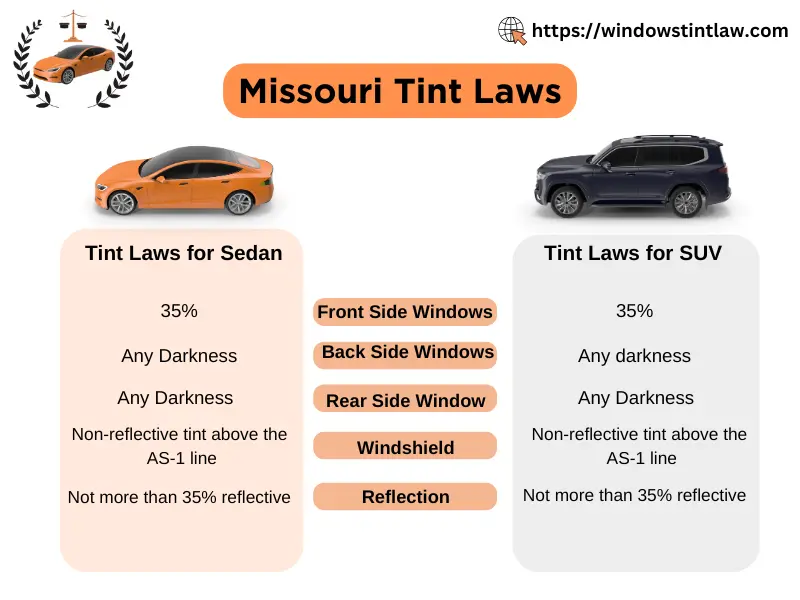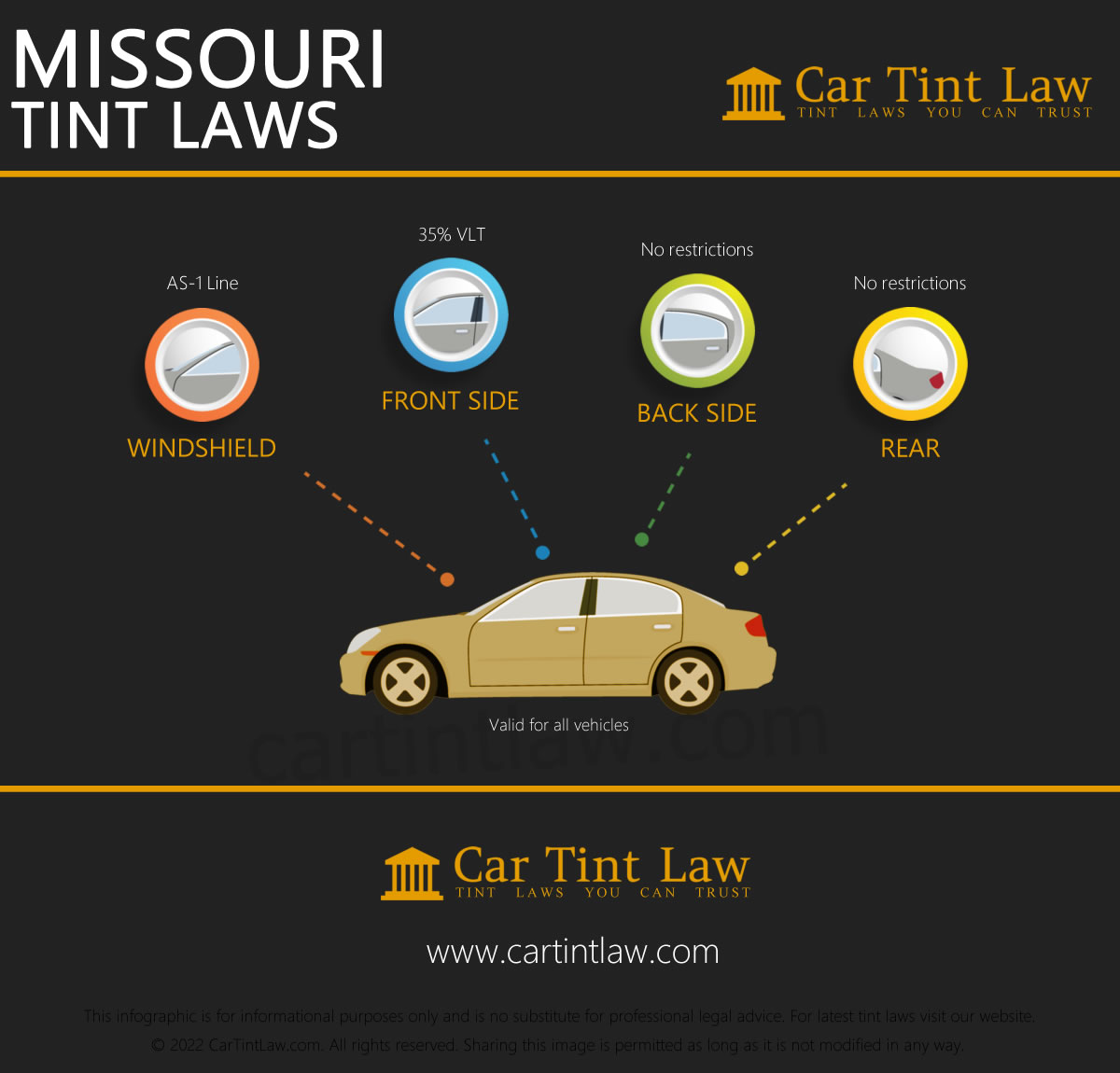Have you ever been driving through Missouri and wondered if your car’s tinted windows are in compliance with state regulations? You’re not alone.
Understanding the Missouri Tint Law is crucial for anyone who wants to avoid fines and ensure their vehicle is road-ready. But navigating legal jargon can be a headache. That’s why we’re here to break it down for you. Imagine cruising with peace of mind, knowing that your window tint is perfectly legal.
You’ll discover everything you need to know about the Missouri Tint Law, including the dos, the don’ts, and a few surprising facts that might just save you from an unexpected ticket. Keep reading to make sure you’re in the clear when it comes to tinting.

Credit: www.atrstl.com
Missouri Tint Law Basics
Driving through Missouri, you might notice the varying degrees of window tint on cars around you. This variation is largely due to the Missouri Tint Law, which regulates how dark or reflective your car windows can be. Understanding these regulations can help you avoid fines and ensure your vehicle is within legal limits. Whether you’re a resident or just passing through, knowing the basics of Missouri’s tint laws is essential for a hassle-free driving experience.
What Is Window Tinting?
Window tinting involves adding a thin film to your car’s windows to reduce sunlight and heat. This film can vary in color and opacity, allowing you to customize your vehicle’s appearance and comfort. Have you ever driven a car with tinted windows on a hot summer day? It can make a noticeable difference in keeping the interior cool and protecting your skin from UV rays.
Purpose Of Tint Laws
Tint laws are in place to ensure safety for drivers and pedestrians. They regulate how much light can pass through your car windows, maintaining clear visibility. Imagine trying to make eye contact with a driver at a busy intersection, only to find their windows too dark to see through. This could lead to misunderstandings and accidents.
Missouri’s tint laws also aim to balance aesthetic preferences with practical needs. While tinted windows can enhance privacy and reduce glare, they must not compromise visibility. Do you think your car’s tint might affect how you perceive traffic signals or pedestrians? It’s worth considering how these laws impact your daily commute and overall driving experience.
Understanding these aspects of Missouri’s tint laws helps ensure you stay compliant and safe on the roads. Consider your own experiences with window tinting—has it ever impacted your driving? Share your thoughts in the comments below!
Legal Tint Percentages
Understanding Missouri’s tint laws is crucial for car owners. The state has specific rules about how dark or reflective window tinting can be. These regulations ensure safety and visibility for drivers. Each window type on a vehicle has its own legal tint percentage. Let’s explore these requirements in detail.
Front Side Windows
Missouri law states that front side windows must allow over 35% of light in. This means that the tint must not be too dark. Drivers need clear visibility. It’s important for the safety of both drivers and pedestrians.
Back Side Windows
Back side windows in Missouri can have a darker tint. The law allows them to be tinted to any darkness. This provides privacy for passengers. It also helps keep the interior cooler in sunny weather.
Rear Window
The rear window follows similar rules as the back side windows. Drivers can tint the rear window to any darkness. This offers flexibility in how much privacy and heat protection they want. Just ensure the vehicle has side mirrors for a clear rear view.
Windshield Regulations
The windshield has stricter tinting rules. Only the top part of the windshield can be tinted. A non-reflective tint is allowed above the AS-1 line. This helps reduce glare while driving. But the main part of the windshield must remain clear.
Exceptions And Exemptions
Missouri’s tint law includes specific exceptions and exemptions. These rules help accommodate unique needs and situations. Understanding these exceptions can prevent legal issues and ensure compliance. Below, we explore two main areas where exceptions apply: medical exemptions and commercial vehicle regulations.
Medical Exemptions
Some individuals require special window tinting due to medical conditions. Missouri law allows for medical exemptions in such cases. To qualify, drivers must have a doctor’s prescription. This prescription must state the need for special tinting. The law ensures that those with health conditions remain protected while driving. It is crucial for affected individuals to carry this documentation. Proper documentation avoids penalties during traffic stops.
Commercial Vehicle Regulations
Commercial vehicles also have specific tint regulations. These vehicles often require different window treatments. Missouri law provides exemptions for certain commercial vehicles. The exemptions ensure that business operations run smoothly. Operators must ensure their vehicle tint meets industry standards. The law balances safety with operational needs. Understanding these exemptions helps business owners remain compliant.

Credit: windowstintlaw.com
Penalties For Non-compliance
Understanding the penalties for non-compliance with Missouri’s tint laws is crucial. These laws are in place to ensure safety for drivers and pedestrians. Violating these regulations can lead to various repercussions. This section focuses on the consequences of ignoring tint laws in Missouri.
Fines And Citations
Drivers caught with illegal window tint face fines. The fine amount varies depending on the violation. First-time offenders might pay less than repeat offenders. Citations are issued to document the violation. These citations serve as official records of the infraction. Law enforcement officers use them to track compliance history.
Impact On Vehicle Inspection
Non-compliance affects vehicle inspection results. Cars with illegal tint may fail inspection. This failure can prevent you from renewing your registration. Inspectors check tint levels during routine vehicle checks. Ensuring your tint follows legal guidelines is essential. Proper compliance avoids inspection complications and legal issues.
Tips For Choosing Legal Tint
Choosing the right window tint for your car involves understanding Missouri’s tint laws. Not all tints comply with state regulations. It’s crucial to make informed choices to avoid fines. Consider these tips to ensure your tint is legal and effective.
Consulting Professionals
Speak with a tint specialist. They understand Missouri’s specific tint laws. Professionals ensure your tint meets legal requirements. They provide guidance on permissible darkness levels. This helps prevent costly mistakes. Experts can suggest high-quality, legal tint options.
Understanding Tint Labels
Tint labels provide essential information. Check the label for visible light transmission (VLT). Missouri laws specify minimum VLT percentages. Ensure the tint’s VLT complies with these rules. Labels also indicate UV protection levels. Understanding these details helps in selecting the right tint.

Credit: www.cartintlaw.com
Recent Changes And Updates
Missouri’s tint law has seen significant changes recently. These updates aim to balance safety with personal preferences. Understanding these changes is crucial for residents and visitors alike.
New Legislation
Recent legislation in Missouri affects car window tinting regulations. The new law sets limits on tint darkness. It ensures that drivers have clear visibility. Front side windows must allow more light to pass through. This change aims to reduce accidents and improve road safety. Rear windows have more flexibility. They can be darker, providing privacy to passengers. Enforcement of these regulations is strict. Non-compliance may result in fines or penalties. It’s important to stay informed and adhere to the new standards.
Future Trends In Tint Laws
Future trends in tint laws show a move towards more transparency. Authorities are considering technology advancements in window films. Smart glass technology might change regulations further. It offers adjustable tint levels based on lighting conditions. This innovation could enhance safety and comfort. Policymakers will likely focus on balancing technology with safety needs. Environmental factors may also influence future laws. Tinting affects vehicle energy consumption and emissions. Monitoring these trends helps anticipate upcoming changes in regulations.
Frequently Asked Questions
What Is The Darkest Tint Legal In Missouri?
Missouri allows a maximum of 35% tint on front side windows. Back and rear windows can have any tint level. Keep your vehicle compliant with state regulations by following these guidelines.
In What State Is 20% Tint Legal?
20% tint is legal in several states, including Arizona, Colorado, and Florida. Check local regulations for specifics. Always consider state laws and updates, as tint rules can vary. Ensure compliance to avoid fines or penalties. Consult local authorities or official resources for accurate, current information.
Do Missouri Cops Care About Tint?
Missouri cops enforce tint laws strictly. Window tint must comply with state regulations. Excessive tint can lead to fines. Officers check tint during routine traffic stops. Ensure your vehicle’s tint meets Missouri standards to avoid penalties.
Should I Get 35 Or 20 Tint?
Choose 35 tint for moderate privacy and visibility; go for 20 tint for increased privacy with reduced visibility. Consider local laws and your preference for aesthetics and sunlight protection. Both options enhance style and interior protection. Ensure compliance with regulations for a safe and legal choice.
Conclusion
Understanding Missouri’s tint law is essential for drivers. It ensures safety and compliance. Tinted windows offer privacy and protection from sunlight. But laws regulate how dark they can be. Knowing these rules helps avoid fines. It keeps your vehicle legal.
Always check local updates. Regulations may change. Staying informed is key. Consult professionals for installation. They ensure your tint meets legal standards. This keeps your driving experience smooth and stress-free. Make informed decisions about your vehicle. Protect yourself and others on the road.
Safe driving starts with legal compliance.
